In NORMAN! Part 2, I had gotten approval to foster NORMAN after the dog introduction (which had started a bit rough but then settled down sufficiently). I had gotten a crate and the other necessary stuff and it was time to take him home. He was acting a little bit stressed in his crate but that’s fairly normal. The one thing I should have done in hindsight was kenneled ALFIE! so that I could let NORMAN! run around the house and sniff a bit first before they interacted. Maybe I’ll get it right for dog number three.
Table of Contents
The Second First Impression
When we do dog introductions at the Austin Humane Shelter, it’s effectively neutral ground (I’m not sure that any of the shelter dogs really see the shelter as their ‘territory’). But it was different bringing NORMAN home to the house since this was ALFIE’s territory and he’d been an only dog going on a solid 8 months (and we’d been in the house since January).
So now I was bringing the young interloper NORMAN into ALFIE’S territory and had to be prepared for the worst in case ALFIE! lost his shit and a fight started. He didn’t but the first few interactions were pretty similar to the initial introduction.
A bit of growling and aggression, maybe a bit on the rougher side, I mainly had to just watch carefully. So long as it wasn’t escalating into an all-out fight (and make no mistake they still play a bit roughly and I have found small cuts from time to time), I wasn’t too worried and felt confident that they’d work it out. Hopefully without any straight up murder going on.
Jumping ahead, I’ve had NORMAN! here for just over 10 weeks and most of the initial problems, some of which I’ll describe shortly, are gone. Play time can still get a bit rough but I put them on time out when it gets too mouthy or bitey for my liking. Just so that they don’t learn that biting on each other (or worse yet, on people) is an acceptable thing. Some of this was even training myself not to roughhouse with them. It may be fun but ultimately teaches them that being rough with humans is acceptable and that’s not a good thing.
Also, as much as I enjoyed watching them hump one another (sometimes you have to get your entertainment where you can), I did decide to break them of it and they’ve mostly stopped. Mind you they’ve now replaced humping with another related behavior; the picture is always a great conversation starter.
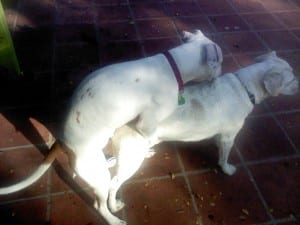
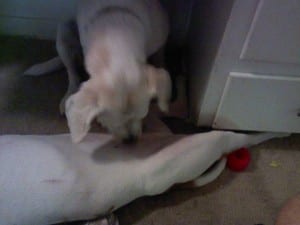
Anyway, I think the main reason I wanted to make sure that they got along well is that, by the time he’s full grown, NORMAN! will outweigh ALFIE! by quite a bit. I didn’t want NORMAN! to finally realize that he could kick the crap out of ALFIE! once he got to his maximum weight of about 60-70 pounds (ALFIE! was already at his adult weight of 40 pounds).
Mind you, the lack of straight up murder didn’t mean that there wouldn’t be plenty of other specific issues to deal with. Puppies, effectively, are a full time job in a lot of ways and this was compounded by the presence of a second dog. And I really didn’t know what I was getting myself into when I decided to foster/adopt NORMAN! And to a great degree, despite all of the things I’ve learned volunteering at the Austin Humane Shelter, I wasn’t prepared for a lot of things I’d have to deal with because it’s not stuff we do at the shelter. But before I get to that.
Foster to Adopt
The short version of what happened with NORMAN! overall was that I was initially just fostering him. As I talked about in NORMAN! Part 1, this goes on a lot, folks will take a dog home on a temporary basis (a few weeks to a few months) for a variety of reasons, generally with the intention of bringing them back to the Austin Humane Shelter after the foster period is over. The foster program, like everything at the Austin Humane Shelter is well set up and organized; if nothing else the shelter covers medical costs for anything that happens during the fostering period.
And even though I had every intention of adopting NORMAN!, I was told to keep him on foster at least until his leg was checked out. He was on kennel rest (meaning he was really supposed to be constrained to his crate and short potty breaks) for a few weeks before his second x-ray. If it went well, he’d be fine and I could adopt; if not he’d need surgery but the Austin Humane Shelter would cover it. Keeping him as a foster was mainly to avoid my having to pay for the surgery if it happened.
As a foster, my job was to give him that extra bit of socialization and mental well being during his kennel rest period so he could heal. I will admit that I probably let him run around a bit too much while he was supposed to be healing but I was told that so long as he didn’t show signs of pain or discomfort it was ok.
Frankly, I didn’t have much control over it because of the presence of ALFIE! They’d get together and want to run around a bit and I’d let them for a little while. As NORMAN’S leg healed, I also would take him for very short walks outside so that his life wasn’t constrained to kennel, back yard, kennel, back yard.
Three weeks later, I took him to his final vet visit, his leg was checked out and everything came back 100% so he was cleared. I went to the shelter and filled out the paperwork, would take NORMAN for his free vet checkout at VCA (this comes with the adoption) to make sure he wasn’t carrying any residual stuff and now he was mine.
Now the real headaches would start.
Two Dogs, Three Issues
.
Two Dogs, Three Issues
Basically, I had three different dog issues to deal with in general. The first, of course, was continuing to train ALFIE! and making sure he didn’t feel like he was getting replaced by the ‘new kid’ (I continually call NORMAN! little brother although he’ll end up outweighing ALFIE! by the time it’s all said and done as I mentioned above).
He’s still high-energy, he still needs daily cardio and NORMAN! wasn’t up for long walks initially because of his leg. That would mean taking ALFIE! out on his own and I basically maintained his training as it was working on the stuff I was working on (which I’ll detail in another ALFIE! post at some point). And giving him sufficient individual love so he didn’t feel like the second child in the house.
The second was starting NORMAN!’s training by himself. In one sense this was the least of my issues as I was simply going to train him on the same exact stuff I’d been doing with ALFIE! Things like Red Light/Green Light, not to pull (I only recently learned how to teach loose leash walking), my version of down, etc.
But I had to start with the basics and build up until I could maybe train them together; certainly I had figured some stuff out over the past 9 months that would make it easier the second time around. And at least on some things NORMAN! did pick it up faster. Whether it’s because he’s a puppy, was watching ALFIE or because I’m better at it I have no idea; I’ll just assume all three are involved.
One issue that having the two of them brought to light is that I had missed some of the very basic training stuff with ALFIE!. Frankly, a lot of it never occurred to me. Things like getting him to come on command as an example. ALFIE! basically followed me around the house as it was so it was never an issue. And on walks he was always on leash.
Now ALFIE has gotten to the point where he doesn’t pathologically follow me all the time; NORMAN has taken up in his stead. A lot of rescue dogs seem to have some separation issues, I suspect they fear abandonment again. So NORMAN is a bit needy at times and I’ve pretty much always got at least one dog underfoot or underdesk. Usually two as shown below.
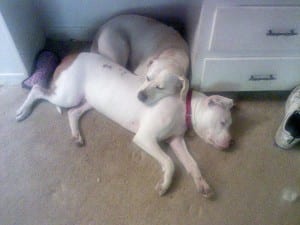
But once I started walking him with NORMAN! it became an issue since I needed to be able to call them back to me during the chaos that was dual dog walking. As well, I had never really worked specifically on name recognition, never an issue with one dog.
But with two dogs I needed them to respond to their individual names which meant teaching them to respond to them (short version, you call their name and when/if they make eye contact you treat them so that they learn that responding to their name is a good thing). There were other things and mainly I’d just worked with ALFIE! on things we did at the shelter; but there were definitely gaps in his training. I’d have to back up to square one on a lot of stuff and do it with both of them.
Two Dogs, Two Personalities
I noticed fairly early on that ALFIE! and NORMAN! are very different dogs in terms of personality and learning. NORMAN is, a bit, shall we say, obsessive and he seems to pick up certain things faster. He also seems better at generalizing behaviors meaning that once he learns something somewhere he understands that it applies in other situations.
At the same time he’s also got that puppy enthusiasm (and being on kennel rest early on didn’t help since I couldn’t just walk him to exhaustion) which interacts with his breed and temperament and it can add up to me getting really frustrated at times.
I also had a tendency to forget that I had had ALFIE for longer and a lot of the basic stuff I had taught him were already well-established. With NORMAN! I fell into a trap of thinking he should be responding as consistently without remembering that he hadn’t had 9 months of consistent work on fundamental stuff. That was my fault and I still have to force myself to be patient with him.
Probably NORMAN!’s biggest issue is that he seems to have a trigger switch, something will set him off (and mind you some of this is just being a puppy) and when that happens all bets are off. He won’t respond to commands when he dials himself up to about 11 and he just goes nuts until I wait him out.
This was a real problem with walks sometimes as he’d lose his shit for some random reason (like he’d sniff a pile of mud and then just lose it) and start snapping or barking/growling. And that would set ALFIE! off who is still a bit dog reactive and can get snappy when he gets worked up. And there’s not a lot you can do when you have two dogs attached to you by 6 foot leashes and they are going at one another.
In contrast, ALFIE! seems to take a bit longer to pick stuff up and it seems like I have to teach it to him more places for it to sink in. He’s also, well, a bit of a pushover and I can get him to do what I want a bit easier. It certainly helps that both dogs are insanely food motivated so treats can pretty much get them to do anything. I can even use kibble (considered a ‘low-value’ treat) as a reward and they are plenty happy with it; no need to use anything more expensive.
Honestly, I can sum up the difference in the two dogs with this picture, possibly my favorite of all that I’ve taken (it’s currently the picture on my phone).
.
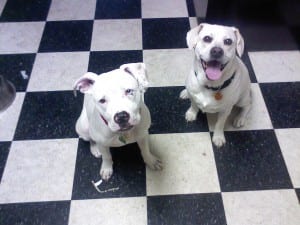
Make no mistake, I love ALFIE! but he’s, well, he’s not the brightest bulb in the bunch. You can see it in his face, he has the joy and pleasure of the simpleminded. NORMAN! on the other hand is intent and serious and I’m fairly sure that if he ever figures out how to get to the food, I’m out of here. Here’s another couple of NORMAN, still with his puppy head (it’s been interesting watching it and him change shape) and you can see the murder in his eyes. Maybe.
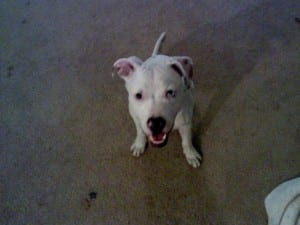
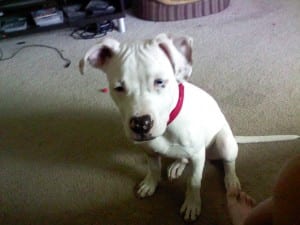
Like I said, there are distinct differences between the dogs, surely as a function of breed, age and just overall temperament (animals, like humans differ in “personality” to a great degree). And this does actually impact on how I have to interact with them.
Of Dominance, Submissions and Semantics
As it turned out, about halfway into my initial time with NORMAN! I was invited to take the Yellow dog class (the next ‘level’ up in terms of behavioral issues) at the Austin Humane Shelter. I had been on the fence (so to speak) about it for a while, wasn’t sure I wanted the responsibility or not but went ahead and signed up. It turned out to be a good thing if, for no other reason, it gave me some tools and games I could use with my own beasts to get them better trained.
But among other things that we have discussed is the current debate in the dog training literature over the issue of dominance, submission, leadership, etc. In brief, there is sort of a developing idea that the strict dominance hierarchies that exist in wolves (and were thought to exist in dogs) may not exist in such strict forms in either.
And that the idea of dominance and submission (in their strictest sense) may be an incorrect approach to dog training. In addition, there is great debate over whether dogs see humans as ‘part of the pack’ and look upon them as dominant or what have you. This was something that got brought up in the comments section when I first wrote about ALFIE when I made some comments about things like going through the door first and such.
Frankly, it seems to me to be a bit of semantic wordplay more than anything although it has some subtle implications for how many are going about actually doing the dog training. Overall there is just more of a focus on positive methods and avoiding most forms of direct punishment compared to more old school approaches which seemed to revolve around more force, positive punishment and things of that nature..
Frankly, the Austin Humane Shelter focuses on positive training methods anyhow and a lot of what is talked about is how the humans establishes leadership through things like controlling the resources, consistency in training, etc. Which again, doesn’t seem to change much.
Mainly the idea is to eliminate a lot of ‘old school’ ideas like the alpha roll (rolling a dog on his back and pinning him) and other hardcore punishments of that nature. And the positive approach works pretty damn well, at least in that type of controlled setting; even in the year I’ve been there I’ve seen it do some pretty amazing things.
There is also the idea that dogs aren’t necessarily dominant or submissive, at least not in the popular sense of what those words mean. Rather, it’s more an issue of how intent they are in getting what they want (i.e. pulling towards something) versus what you want (not having them pull). Again, I see this as more of a semantic issue than so much of a practical issue; it’s about who’s in charge of the situation and whether the dog does what it wants or does what you want it to.
But overall the human still establishes that they are in charge through things like controlling resources like toys (when the dogs are allowed to play), food, and who gets to do what. In my mind whether you call this leadership or dominance seems to be more an issue of semantics than much anything else; it’s all about who is in charge. And that who should be the human. I also disagree that there is NEVER a time to use punishment which seems to be the most extreme version of the ‘positive approach’ methodology.
There are simply situations where I think that you can’t just ‘wait a behavior’ out or ignore it although they tend to exist at the extremes of behavioral issues (certainly you don’t need to spank your puppy for not sitting on command). One I deal with fairly consistently is when ALFIE and NORMAN are roughhousing and it’s escalating towards an actual fight.
If I ignored it, they’d just start fighting for real; this isn’t a place where I can wait for something good to happen to reward because it’s simply not going to. So I can keep ignoring it and let them bloody one another or I can step in and break things up. Usually that means calling a time out/red light on both of them. If that doesn’t get it done, something more extreme may be required (usually involving body blocking the puppy and or restraining him physically. But it’s one I deal with almost daily.
And it’s one I deal with more with NORMAN than with ALFIE. Again, because of his age, breed, possible lack of socialization and such NORMAN is, well, let’s just say that he’s a lot more stubborn about what he wants. Call it dominance, call it wanting to be in charge, call it whatever you want, the end result is sort of the same and NORMAN will fight a bit harder to get what he wants which may contrast with what I want.
In contrast ALFIE is much more of a pushover, again a function of his breed, age, and overall temperament; call it being submissive or whatever you desire but he accepts my commands a lot more easily. In a lot of ways, my time with him didn’t really prepare me for either a puppy or a harder case dog.
There have also been situations where NORMAN has done things that I think most would have have trouble separating his action from a true dominance display. One that came up very early on was when I started letting NORMAN sleep in the room out of his kennel. He started giving me a 6-6:30am wake-up call when he needed to potty (usually by licking my face) and one time I didn’t get up as quickly as he wanted. He stood over me and growled directly in my face. And I smacked him instantly and unapologetically with a loud ‘NO!’
Because if that’s not a dominance display on his part, I’m not sure what is and I wanted to let him no in no uncertain terms that it was unacceptable. I’d note that it never happened again which is ideally how positive punishment should work (it worked with ALFIE’S humping me so long ago, two smacks to the head and the behavior was extinguished); if you have to keep using it, it’s not working very well and you should probably stop.
Make no mistake, I still try to use positive training methods with both dogs as much as possible for as many training tasks as possible; I don’t like imposing punishment and don’t want them to either fear or hate humans or me. But regardless of whether you want to call it dominance or leadership or whatever, I expect both to recognize who’s in charge.
And this whole debate really just comes down to establishing that it’s the human and how that is best done. I’d note only in passing that ALFIE certainly seems to be submissive to NORMAN overall, letting him go through doors first, giving up toys most of the time or where he’s sleeping if NORMAN wants it. I don’t really care where they see each other in the pack; just so long as they recognize that I’m the only one who knows where the food is kept.
And that’s actually where I’ll cut it today; on Friday I’ll talk about some of the specific training issues I dealt with, how I dealt with them (or how I’m still dealing with them) and then I’ll get back to talking about whatever this site is ostensibly supposed to be about.
Read NORMAN! Part 4.
Similar Posts:
- AHS
- People Do It Because We Let Them: Part 3
- People Do It Because We Let Them: Part 2
- People Do It Because We Let Them
- Bipolar Recovery Update
I love reading your blog, these posts are so great to read. Keep writing!